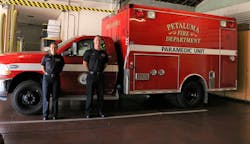Firefighter/Paramedic: Transitioning to a Transporting Single-Role System
The dynamic entity that is the fire service is grappling with a crucial issue: firefighter/paramedic mental health and well-being. These professionals’ dual role is at the heart of the discussion.
The traditional model of cross-training firefighter/paramedics to handle firefighting and transport paramedic duties is under intense scrutiny. A paradigm shift toward a single-role system, where transporting paramedics focus solely on medical duties, is required to improve recruitment, retention and mental health within the fire service.
The case for change
Significant flaws of the long-appreciated flexibility and financial efficiency of the dual-role transporting system are beginning to be revealed.
Yes, training individuals to handle firefighting and transport paramedic duties allows fire departments to provide fire-based ALS and transporting ALS services. However, potential compromises in staff mental health and quality of service that’s provided to the community are becoming increasingly apparent. These issues aren’t statistical anomalies but real, daily challenges.
The case for change is compelling. The dual-role transport system’s inherent strain on personnel leads to high turnover rates, as many firefighter/paramedics leave transporting agencies for non-transporting agencies. Additionally, the constant shift between firefighting and paramedic duties exacerbates post-traumatic stress disorder, depression, burnout and other mental health issues.
My research highlights that the dual-role transporting system can dilute the focus and effectiveness in both roles.
Mental health concerns
The demands of the dual-role transporting model means that firefighter/paramedics must transition rapidly from responding to life-and-death medical emergencies (read: constant exposure to trauma) to fighting fires, often without adequate rest or mental decompression time. This relentless pace creates a high-stress environment that takes a severe toll on their well-being.
Research that I conducted found 11 out of 15 firefighter/paramedics reporting that their dual-role transporting position directly affects their mental health negatively. They identified a lack of support, extended hospital wait times and the emotional burden of traumatic scenes as significant stressors. One member noted, “Ambulances ensure burnout, less sleep and depression and reduce fire training time.” This feedback highlights the critical need for a more supportive and manageable work structure.
By transitioning to a single-role transporting system, fire service agencies can help to mitigate these stressors. One set of responsibilities can provide more opportunities for mental decompression and targeted support.
Recruitment and retention challenges
The fire service’s significant recruitment and retention challenges are particularly problematic in regard to dual-role transporting firefighter/paramedics.
Many individuals join the fire service driven by a passion for firefighting, only to find themselves predominantly assigned to ambulance duty. This mismatch between expectations and reality leads to dissatisfaction among personnel. Furthermore, the emotional and physical demands of dual-role transporting positions and the frequent need for ambulance service can overwhelm these same individuals. As a result, many firefighter/paramedics leave transport agencies for the better work-life balance and reduced emotional strain of non-transport roles, and many departments struggle to maintain adequate staffing. Then, the constant recruitment and training of new personnel, only to see them leave for less-demanding positions, creates a persistent challenge. This revolving door of employees affects operational efficiency and strains resources and morale.
By transitioning to a single-role transport system, fire service agencies can better align job roles with individual preferences and strengths, which would reduce turnover and create a more stable, satisfied workforce.
Quality of service
Although designed to maximize efficiency, the dual-role transporting system can compromise the quality of firefighting and medical services inadvertently.
One of the primary concerns is that firefighters who spend a significant portion of their time on medical calls might not be able to maintain the high level of proficiency that’s required for effective firefighting.
Firefighting demands rigorous, ongoing training and physical preparedness. Without dedicated time for these activities, firefighters might find their skills and readiness deteriorating. This dilution of focus can lead to slower, less effective responses during fire emergencies, which ultimately can jeopardize the safety and well-being of the community.
Paramedics who are also trained as firefighters might struggle to stay current with the latest medical protocols and practices because of their divided attention. Medical care is a rapidly evolving field that requires continuous education and training to ensure the highest standards of patient care. The split focus of the firefighter/paramedic affects performance and overall quality of service.
Transitioning to a single-role transporting system allows personnel to specialize and excel in their respective field, which ensures that firefighting and medical services are delivered at the highest possible standards.
Benefits of a single-role system
Allowing paramedics to focus solely on medical duties and firefighters on firefighting can lead to several benefits.
Improved mental health and job satisfaction. Paramedics who are freed from the demands of firefighting duties can dedicate their efforts to delivering high-quality medical care. It lets them stay updated with medical advancements and protocols, which enhances their professional competence and satisfaction. Similarly, firefighters can concentrate solely on fire-related tasks, including physical fitness, training and emergency readiness. One member noted, “A single-role system would allow more focus and training in firefighting skills and techniques.” This specialization improves their performance and overall job satisfaction.
By transitioning to a single-role transporting system, fire service agencies can create a healthier, more balanced work environment that reduces stress and enhances job satisfaction.
Enhanced recruitment and retention. One of the primary benefits of transitioning to a single-role transporting system is its capability to attract individuals who are specifically interested in either firefighting or transport paramedic work.
By aligning job roles with individual interests and strengths, departments can create a more motivated and content workforce, which is essential for long-term employee retention.
Further, the single-role transporting system can help to mitigate the burnout and dissatisfaction that often accompany dual-role transporting positions.
The focused approach also expands the pool of potential applicants. Individuals who might have been deterred by the dual-role transporting requirements are more likely to apply when they know that they can concentrate on their preferred field. Ultimately, this can lead to a more robust and resilient workforce.
Quality of service. Firefighters who aren’t burdened with transporting paramedic duties can dedicate more time to training and preparedness for fire-related incidents. This ensures that firefighters maintain high expertise and performance during fire emergencies.
Addressing concerns
Despite the benefits of transitioning to a single-role transport system, concerns about service quality and community perception persist. Many fear that outsourcing ambulance services to private companies might lead to declining care standards. This anxiety is compounded by apprehensions about losing control of EMS.
To address these concerns, fire departments must maintain control over transporting single-role paramedic services to ensure high standards and professional accountability. This not only helps to alleviate fears of reduced service but also ensures that departments can implement and uphold stringent quality measures. Internal control allows fire departments to retain oversight and establish clear expectations and accountability within the service contract.
Maintaining control
Maintaining control within the fire department allows for integrated service delivery, where transporting paramedics and firefighters work seamlessly under the same organizational culture and standards.
Unified systems facilitate continuous and consistent training that aligns with departmental protocols and community needs, which fosters a culture of excellence and accountability. This coordinated approach enhances teamwork, communication and operational efficiency, which are crucial in emergencies. Additionally, a fire department-controlled model emphasizes rigorous selection, training and evaluation processes, to ensure only the most capable professionals serve the community.
This model also enhances trust and confidence within the community. Residents can be assured of receiving reliable and accountable public service. Avoiding privatization mitigates potential drawbacks, such as reduced service quality, higher costs and profit-focused care.
Implementing change
Transitioning to a single-role transport system requires careful planning and consideration. Departments must conduct thorough evaluations to understand the financial implications, staffing needs and effects on service delivery.
A detailed cost-benefit analysis is needed to assess financial viability, including training costs, salary adjustments for specialized roles and necessary infrastructure changes.
Staffing must be assessed to ensure that enough transporting paramedics and firefighters meet the community’s demands without overburdening any group. Departments should consider implementing pilot programs to test the single-role transporting system in a controlled environment, providing insights into best practices and identifying unforeseen challenges.
Stakeholder engagement is also crucial. Involving current dual-role firefighter/paramedics in planning can address their concerns and gain support. Clear communication about the new system’s benefits, such as improved mental health and job satisfaction, can help to ease the transition.
Also, robust support systems, including mental health resources and peer support programs, are needed to assist employees during the change.
Monitoring the transition closely and adjusting as required is essential. Regular feedback from employees and the community can identify areas for improvement and ensure that the new system meets its goals of enhanced efficiency and employee well-being.
Financial considerations
Although the initial transition to a single-role transporting system involves costs that are related to training and restructuring, the long-term benefits can offset these expenses. Reducing mental and physical health challenges for one-time firefighter/paramedics potentially lowers costs that are associated with burnout and turnover.
Agencies that operate a single-role transporting systems can experience a more stable workforce, which would reduce recruitment and training costs. Additionally, operational efficiency can be improved as transporting paramedics focus solely on transporting medical duties.
A well-planned transition can also lead to better resource alignment. Firefighter/paramedics can concentrate on fire suppression, while those who are focused on EMS can dedicate their skills to medical care. This can result in overall cost savings and enhanced departmental efficiency.
Training and integration
Transitioning from dual-role transporting firefighters to single-role transporting paramedics necessitates comprehensive training and robust integration strategies.
Advanced medical procedures, patient care and EMS protocols should be the focus for transporting paramedics. Firefighters should concentrate on fire suppression techniques, rescue operations, disaster response and first-response ALS.
Cross-departmental collaboration is essential. This is facilitated through joint training exercises, regular interdepartmental meetings and integrated response units that promote a cohesive emergency response strategy.
Integration strategies also must leverage technology, with shared communication systems and real-time data-sharing to enhance coordination between transporting paramedics and firefighters.
Prioritizing mental health and well-being is crucial, with regular check-ups, counseling services and peer support programs to help to address psychological challenges.
Adapt and innovate
Although historically beneficial for its flexibility and financial efficiency, the dual-role transporting system is proving unsustainable given the current challenges that the fire service faces.
The future of the fire service depends on its capability to adapt and innovate. Fire departments that successfully navigate a transition to a single-role transporting system will enhance their operational capabilities and ensure a healthier, more satisfied workforce that’s capable of providing the highest service to their community.
About the Author

Chad Costa
Chad Costa is the assistant chief for the Petaluma, CA, Fire Department. With more than 26 years of fire service experience, he has worked in various organizations, including CAL FIRE, rural and semi-rural districts, and a city. As a battalion chief, Costa was the technology and communications battalion chief. He is now a rostered operations branch director for CalFire Team 1 and an alternate operations section chief trainee on California Interagency Team 5. Costa is an accredited Chief Fire Officer through the Center for Public Safety Excellence and has a bachelor’s degree in emergency services management, a master’s degree in fire service leadership, and a certificate in homeland security. Costa has also completed the Executive Chief Officer Program at the National Fire Academy. Costa is a member of the Firehouse Editorial Advisory Board.
